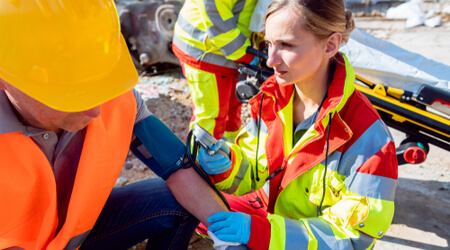
Most construction accidents are preventable. Safety training and education is one of the surest ways to prevent them.
Training in proper work practices has two aspects: 1) learning the use of equipment and procedures that are new to the worker, and 2) learning the particular hazards that exist on a job site.
Training in these areas is a necessary and unavoidable cost of doing business. It is required by federal law under Occupational Health & Safety Administration (OSHA) regulations.
You usually can’t sue your own employer if improper training caused your workplace accident, but you may be able to bring suit against a non-employer subcontractor, general contractor, vendor or other third party if they failed to properly train their people and you were hurt as a result. The recovery of damages in a third-party lawsuit should not affect your right to workers’ compensation, nor should your workers’ comp claim undermine a lawsuit. In fact, it’s typically in an injured worker’s best interest to pursue all possible sources of accident compensation.
Joye Law Firm has been helping injured South Carolinians recover money for medical expenses, lost wages and other losses for more than 40 years. During a free initial consultation, we can walk you through your legal rights and options following a construction accident and answer any questions you may have.
To speak with an attorney, call Joye Law Firm or contact us online today.
Examples of Accidents Related to Improper Training
According to OSHA standard number 1926.21(b)(2): “The employer shall instruct each employee in the recognition and avoidance of unsafe conditions and the regulations applicable to his work environment to control or eliminate any hazards or other exposure to illness or injury.”
Employees who aren’t properly trained may fail to recognize hazardous conditions altogether, or they may recognize a potential hazard but not know how to safely handle it. In either case, improper training can result in catastrophic injury or death, as the following real-world examples from OSHA show:
- The operator of a powder-actuated tool, who never received training in the proper use of the tool, fired the gun into a hollow wall. The nail passed through the wall before striking an un-helmeted carpenter apprentice in the head, killing him.
- A worker suffocated due to a trench collapse caused by a backhoe straddling the trench. There was no means of egress and no protective system in place for the trench worker. An OSHA investigation revealed multiple violations, including a violation of standard number 1926.21(b)(2).
- A plumbing contractor working at an elevation installing pipes, without safety gear, slipped and fell 12 feet to his death. Two OSHA citations were issued, including 1926.28(a), which states that employers must require employees to wear appropriate protective equipment when exposed to a hazardous condition.
OSHA Training Guidelines
OSHA’s training guidelines consist of the following:
- Determining if training is needed
- Identifying training needs
- Identifying goals and objectives
- Developing learning activities
- Evaluating program effectiveness
- Improving the program
OSHA regulations address hundreds of construction industry standards that have training requirements. Failure to address one of these training requirements may be evidence of negligence by a third party.
Multiple employers are typically present on a construction site. It’s not unusual, for example, for there to be laborers, carpenters, roofers, electricians, painters, masons and others working on a project. These subcontractors are employed by different companies, which have a duty to properly train their employees.
The general contractor, too, may be contractually obligated to provide subcontractor training. Certain “certified,” “competent” or “qualified” employees may be charged by an employer with providing training. This complex web of liability will need to be teased apart in order to determine who exactly is responsible for employee training, as well as any accidents that result from improper training.
Did a Lack of Training Cause Your Accident? Just Call Joye Law Firm
Construction sites are dangerous places, and the risks they present to workers can never be completely eliminated. Proper training, though, goes a long way toward reducing the risks.
If you suspect that a lack of training contributed to your construction site accident, it’s in your best interest to discuss what happened with an experienced South Carolina personal injury lawyer.
Get started with a free consultation. Call Joye Law Firm now or use this online contact form.
Sources:
- U.S. Department of Labor/Occupational Health & Safety Administration:
- Safety and Health Regulations for Construction
- Training Requirements in OSHA Construction Industry Standards and Training Guidelines
- CED Engineering – OSHA Fatal Facts: Fatalities Caused by Improper Work Practices
































